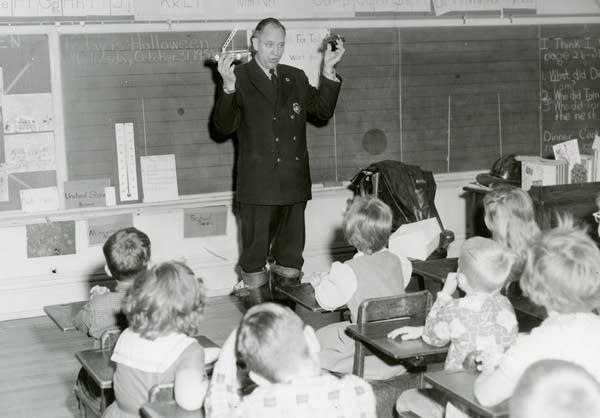Minneapolis' past finds new life in digital image archive

Go Deeper.
Create an account or log in to save stories.
Like this?
Thanks for liking this story! We have added it to a list of your favorite stories.
A historic treasure trove of formidable proportion is tucked away at the base of the Minneapolis City Hall clock tower.
"It's the coolest place in the city," said Josh Schaffer, city records manager.
Schaffer is among those working to bring new life to the holdings of the former Municipal Information Library, which closed in 2003, and the city of Minneapolis' archives.
More than 400 photographs, blueprints, letters and videos are now available to view online via the City of Minneapolis Archives Flickr page.
Turn Up Your Support
MPR News helps you turn down the noise and build shared understanding. Turn up your support for this public resource and keep trusted journalism accessible to all.
The online image gallery, which went public this month, represents a sample of the hundreds of thousands of materials housed inside the clock tower.
The physical space, which is open by appointment only, is impressive. In total, it occupies 4,714 square feet shared among two floors and four mezzanines. Nearly every inch of wall is consumed by shelves laden with documents — many bound, some boxed — that detail the city's history and government activities. Rolled up like holiday gift wrap, design schematics, maps and other large illustrations are tucked here and there. A hodgepodge of filing cabinets cover much of the floor.
"There are gigantic, century-old ink-drawn plat and parcel books that show Minneapolis, block by block; glass plate negatives and 16-mm films — such as one of the Farmers Market from 1936; handwritten records from the municipal cemetery at East Lake Street & Cedar Avenue South; scrolls of building plans from the turn of the century; and City Council proceedings from 1858, hand-written in steady, flowing cursive," wrote Twin Cities reporter Jeremy Stratton after a tour in 2005.

Schaffer, who is in his first year as city records manager, readily admits that wrangling what has been a largely unmanaged and uncatalogued collection is no easy task. It's outright daunting, he said.
Students from St. Catherine University's library and information science program spent spring semester working on inventorying and assessing materials. This summer, the city clerk's office — with assistance from the city's Urban Scholars summer internship program — scanned photographic prints and other records to create a cornerstone for the online collection. The Minneapolis Fire Department's strong showing in the current digital offerings is due, in part, to the existence of several meticulously compiled scrapbooks.
Moving forward, Schaffer intends to continue expanding the digital archive. That means turning to more interns, collaborating with academic institutions that offer archive-related studies and evaluating the feasibility of citizen archivists.
"We really want to make all these wonderful records available," said Schaffer, who describes the archive holdings as "one of the best assets we have as a city."
Folks who have questions or interest in the archiving effort can contact city staff at: archives@minneapolismn.gov. In addition, Schaffer encourages Flickr visitors to share personal knowledge about the people and events in the photographs.







